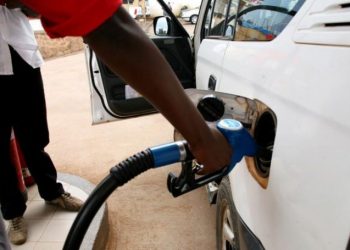The Institute of Energy Security (IES) has projected fuel prices to go higher following the fall of the Cedi against the Dollar.
The energy think tank’s analysis of the foreign exchange (Forex) market over the last two weeks revealed a further depreciation of the Cedi against the US Dollar.
The Ghana Cedi depreciated by a significant 2.5% from the previous rate of ¢10.53 to the current rate of Gh¢10.89, to the US Dollar.
To that end, “The Institute for Energy Security (IES) projects an increase in price for all major products at the pump, due to the increases in the price of the products on the international market, and the significant decline in the value of the local currency against the greenback.
“The sharp rise in Gasoline and Gasoil prices on the global market may drive the price of domestic Gasoline and Gasoil to rise higher, as against the rise in LPG price. In IES’ estimation, consumers of Gasoline and Gasoil may pay between 7 and 12 percent more for a liter at the pump in the next two weeks, with the Gasoil per liter price hinging close to Gh¢15. Although the rise in the price of LPG on the world market was moderate, the significant fall in the value of the Cedi may cause the domestic selling price to rise by not less than 4 percent at the local pump.
“It must also be noted that competition for market share will account for variance in the rate of increases at the pump, across various OMCs”
Read full statement below
REVIEW OF OCTOBER 2022 FIRST PRICING-WINDOW
Local Fuel Market Performance
Prices of finished products on the local market saw changes in the last pricing window across all Oil Marketing Companies (OMCs) monitored, as projected by the Institute for Energy Security (IES). The national average price per litre of Gasoline now stands at Gh¢11.05 up from Gh¢10.90 in the last window, representing a 1.36% increase. Gasoil’s national average price per litre fell to Gh¢13.98 from Gh¢14.45 representing a 3.25 percentage reduction.
The IES MarketScan picked Sel, GOIL, Total, and Shell/Vivo as OMCs with the highest-priced fuel on the downstream petroleum market. Benab Oil, Star Oil, Zen Petroleum, Goodness Oil, and Petrosol were spotted as the OMCs with the least-priced fuel on the local fuel market.
World Oil Market
The International Benchmark Brent saw a 1.82% price increase over the previous window’s average price of $89.47 per barrel to the present average price of $91.10 per barrel, on the back of OPEC+’s production cut pronouncement. The OPEC+ announcement of their production cuts spooked traders and analysts forcing prices to highs of $97 per barrel.
OPEC+ at its 45th Joint Ministerial Monitoring Committee meeting held in Vienna on October 5th agreed to cut daily oil production by 2 million barrels per day. The cut is the biggest oil production cut since the start of the Covid pandemic. The size of the cut, equivalent to around 2% of global daily oil production, was significantly larger than the expected figure of 1 million barrels per day (bpd). However, following the International Money Fund’s (IMF’s) further warning of an increased risk of a global recession, oil prices began falling from the $97 per barrel highs to below $95 per barrel. Coupled with that was traders’ re-assessment of the OPEC+ production quota cut and its impact on the supply of the market.
Adding to the bearish sentiment, Shanghai, and Shenzhen, and other Chinese cities, increased Covid-19 testing efforts, with some local municipalities closing social centers as infection numbers climb.
World Fuel Market
On the global fuel market as monitored on Standard & Poor’s (S&P’s) Platts platform within the just-ended pricing window, liquid and gas fuel prices saw sharp changes following a surge in crude oil prices on the world market.
Gasoline shot up sharply by 15.72%, from its initial price of $833.68 per metric tonne to the end date price of $964.75 per metric tonne.
Gasoil price also rose sharply by 9.60% from its earlier price of $1001.05 per metric tonne to close the window at $1097.18 per metric tonne. LPG’s price on the international market also increased by 3.81% from a previous $595.65 per metric tonne price to an end-date price of $618.34 per metric tonne.
Local Forex
IES Economic Desk’s analysis of the foreign exchange (Forex) market over the last two week reveals a further depreciation of the Cedi against the US Dollar. The Ghana Cedi depreciated by a significant 2.5% from the previous rate of Gh¢10.53 to the current rate of Gh¢10.89, to the US Dollar.
IES PROJECTIONS FOR OCTOBER 2022 SECOND PRICING-WINDOW
The Institute for Energy Security (IES) projects an increase in price for all major products at the pump, due to the increases in price of the products on the international market, and the significant decline in the value of the local currency against the greenback.
The sharp rise in Gasoline and Gasoil prices on the global market may drive the price of domestic Gasoline and Gasoil rise higher, as against the rise in LPG price. In IES’ estimation, consumers of Gasoline and Gasoil may pay between 7 and 12 percent more for a liter at the pump in the next two weeks, with Gasoil per liter price hinging close to Gh¢15. Although the rise in price of LPG on the world market was moderate, the significant fall in the value of the Cedi, may cause the domestic selling price to rise by not less than 4 percent at the local pump.
It must also be noted that competition for market share will account for variance in the rate of increases at the pump, across various OMCs.
Source: Publicagendagh.com
 Public Agenda NewsPaper Ghana's only Advocacy & Development Newspaper
Public Agenda NewsPaper Ghana's only Advocacy & Development Newspaper






